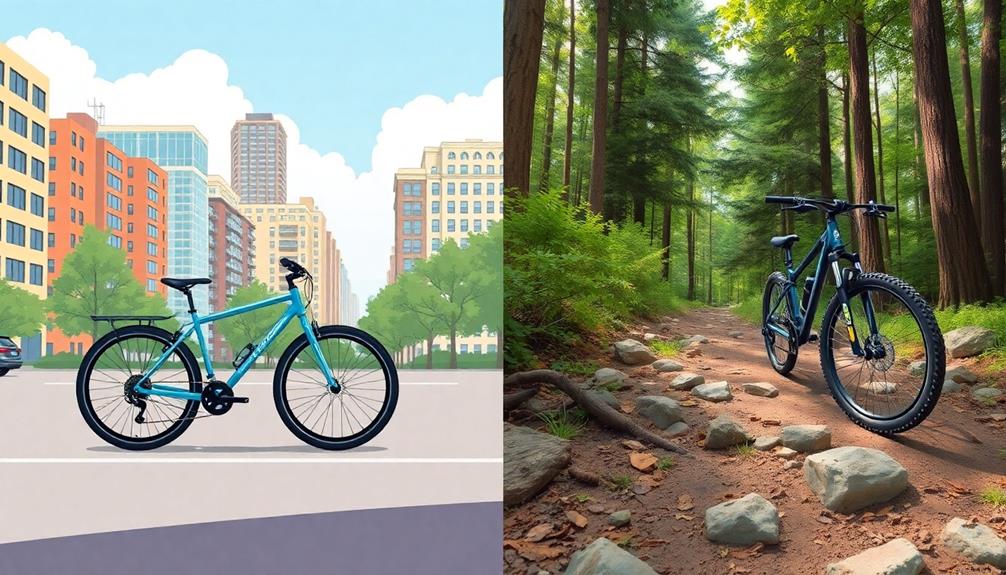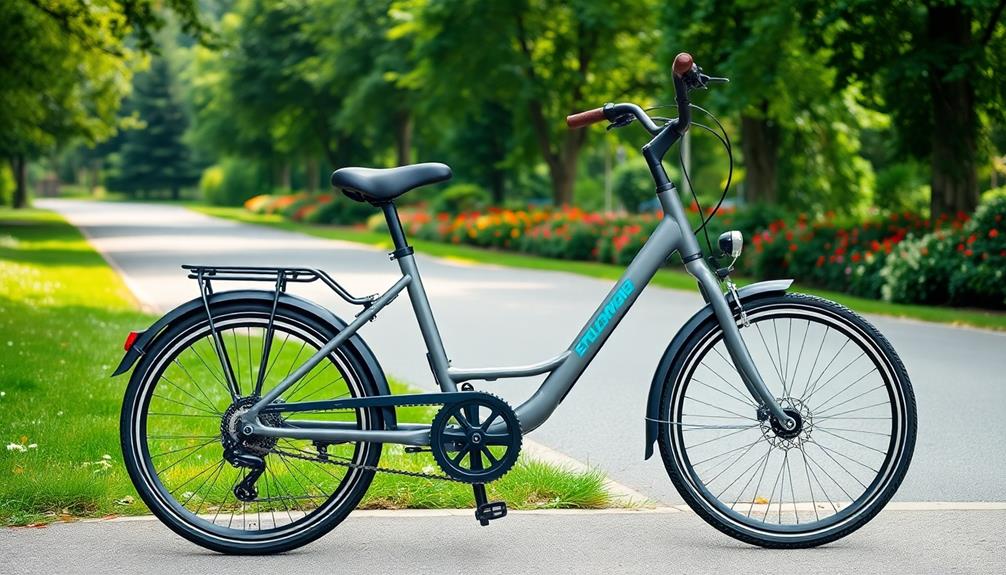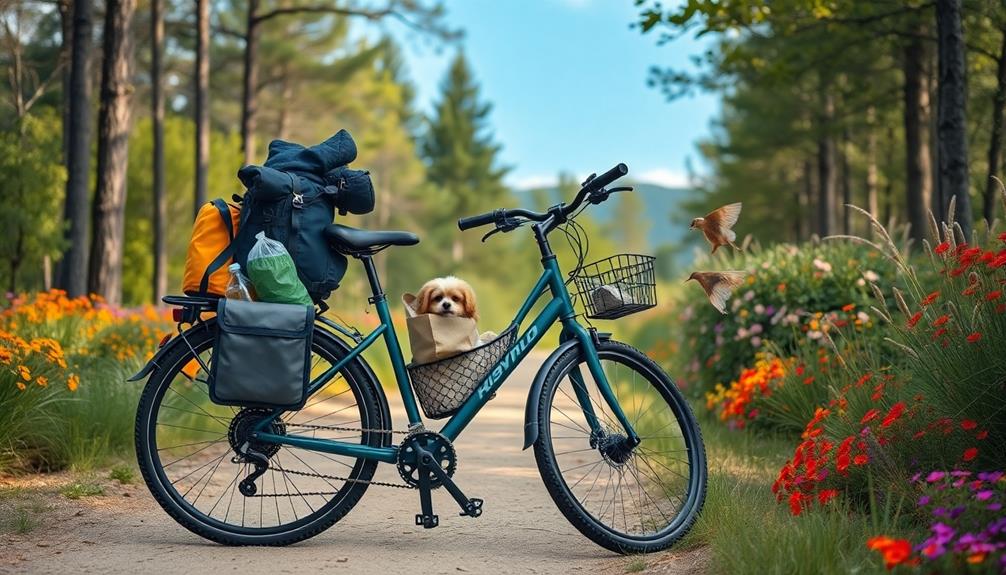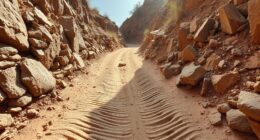When deciding between hybrid and road bikes, think about your riding style and terrain. If you prefer speed on smooth surfaces, a road bike is your best bet with its lightweight frame and aerodynamic design. However, if you want versatility and comfort, a hybrid bike is ideal, offering an upright position and wider tires for better handling on varied terrains. Hybrids require less maintenance and excel in urban environments, while road bikes focus on high performance. Your choice hinges on whether speed or adaptability matters more. Explore further to uncover more insights on which bike fits your lifestyle best.
Key Takeaways
- Terrain Suitability: Choose road bikes for smooth surfaces and speed; opt for hybrids for versatility on urban streets and light trails.
- Comfort and Fit: Hybrids offer an upright position and cushioned seats, while road bikes have an aggressive geometry that may require adjustment.
- Intended Use: Hybrids are ideal for commuting and carrying gear; road bikes focus on performance for racing and long-distance rides.
- Maintenance Needs: Hybrids demand less frequent maintenance due to sturdy construction; road bikes require meticulous upkeep for optimal performance.
- Price Considerations: Hybrids typically start around $350, while road bikes are pricier due to lightweight materials and specialized components.
Bike Types Overview
When choosing a bike, understanding the different types available can make all the difference in your riding experience.
Road bikes are designed for speed and efficiency on paved surfaces. With lightweight materials and drop handlebars, they promote an aerodynamic riding position ideal for bike buyers focused on performance. For those looking to enhance their vehicle's performance, similar to tuning a GMC Sierra for improved horsepower, understanding bike specifications can also lead to better riding results.
If you're looking for comfort and versatility, hybrid bikes might be your best bet. They merge the benefits of road and mountain bikes, offering an upright position with flat handlebars that make for a relaxed ride on various terrains.
Cyclocross bikes take things a step further, combining features from both road and mountain bikes. They sport wider tires for off-road capabilities while retaining some aerodynamic elements.
For those planning long rides, touring bikes prioritize comfort and stability, often equipped to handle racks and panniers for carrying gear.
Comfort and Fit Comparison

Finding the right bike for your comfort and fit can greatly enhance your riding experience. If you prefer a more relaxed ride, hybrid bikes are designed with an upright riding position and larger, cushioned saddles, making them perfect for casual rides. Their geometry prioritizes comfort, allowing for better handling stability at lower speeds.
Plus, wider tire widths (28-32 mm) provide better shock absorption on rough surfaces, improving overall comfort. Additionally, just as the cost of home security systems varies based on customization options, the choice of bike may also depend on personal preferences and specific riding needs, including the type of terrain you plan to tackle factors influencing costs.
On the other hand, road bikes come with an aggressive geometry that emphasizes speed and performance. While their drop handlebars may help you cut through the wind, they can require an adjustment period for new riders.
The narrower tires (23-28 mm) are optimized for paved roads, but they may not be as forgiving on uneven terrain, leading to discomfort.
Proper bike fit is essential for both types. Hybrid bikes allow for a more relaxed seating position, while road bikes may need precise adjustments to guarantee comfort over longer distances.
Ultimately, if your priority is comfort for shorter, casual rides, hybrid bikes are likely your best bet. If you're focused on speed and performance, though, road bikes might suit your needs despite potential discomfort.
Performance and Handling
Performance and handling are essential factors to take into account when choosing between hybrid and road bikes. If you're after speed and efficiency on smooth surfaces, road bikes are your best bet. Their lightweight frames and aerodynamic geometry enhance performance, allowing for quick acceleration and superior handling. The narrower tires (23-28 mm) reduce rolling resistance, making it easier to maintain high speeds.
In contrast, hybrid bikes excel in commuting efficiency while also providing fitness benefits, making them a great choice for urban riders.
On the other hand, hybrid bikes offer versatility and stability. With a more relaxed geometry and wider tires (28-32 mm), they provide better traction and comfort across various terrains. This design makes them ideal for casual riders and urban environments where control and visibility are vital.
The flat handlebars on hybrids give you a more upright position, which improves handling in tight spaces.
While road bikes excel in speed and aerodynamics, hybrid bikes sacrifice some performance for adaptability. If you're looking for a bike that can handle different riding conditions while still providing a comfortable ride, hybrids might be the way to go.
Ultimately, your choice will depend on whether you prioritize high performance or versatility in your biking experience.
Maintenance and Durability

How do maintenance and durability influence your choice between hybrid and road bikes? When considering daily use or casual rides, hybrid bikes stand out due to their sturdy construction and robust components, requiring less frequent maintenance. This makes them ideal for commuting or leisurely rides, ensuring a more forgiving ownership experience.
Additionally, features such as lightweight design in some hybrid models can enhance comfort during longer rides. On the other hand, road bikes demand meticulous care due to their lightweight, high-performance components. Regular checks for tire pressure, alignment, and wear items are essential to maintain peak performance.
While hybrid bikes often allow for easier repairs and modifications, accommodating accessories like fenders and racks without extensive adjustments, road bikes may incur higher long-term maintenance costs. The specialized parts and frequent replacements of wear items, such as tires and chains, can add up over time.
Understanding the maintenance needs of both bike types is significant. If you're looking for a bike that fits your lifestyle with minimal upkeep, a hybrid might be the way to go.
But if you're aiming for speed and performance, be prepared for the additional maintenance responsibilities that come with road biking. Ultimately, your choice will depend on how much you value durability versus high-performance features.
Choosing the Right Bike
Maintenance and durability play a significant role in your bike choice, but other factors like terrain, comfort, and intended use also come into play.
When deciding between a hybrid and a road bike, consider these key aspects:
- Terrain: Road bikes shine on smooth, paved surfaces, while hybrids offer versatility across urban environments and light trails. Additionally, if you're planning on tackling gravel paths, it may be beneficial to explore changing gears on a gravel bike for a smoother ride.
- Comfort Preferences: Hybrids usually provide an upright riding position and cushioned seats, making them ideal for casual riders. In contrast, road bikes have a more aggressive geometry that might take time to adjust to.
- Intended Use: If you're commuting or need to carry gear, hybrids often come equipped with racks and fender mounts for practicality.
Also, think about the price range. Hybrids generally start around $350, making them more budget-friendly, while road bikes tend to be pricier due to lightweight materials.
Finally, keep maintenance in mind; hybrids require less upkeep, which can save you money in the long run.
Ultimately, your choice between a bike vs hybrid bike boils down to how you plan to ride and what fits your lifestyle best.
Frequently Asked Questions
What Are the Disadvantages of Hybrid Bikes?
Hybrid bikes can feel heavier and slower due to their frame and wider tires. You might experience increased rolling resistance, less aerodynamic design, and limited hand positions, which can make longer rides less comfortable and efficient.
Is a Hybrid Bike Good for Road Cycling?
Imagine gliding effortlessly on smooth pavement; a hybrid bike's comfort might entice you. However, you'll notice its speed lags behind dedicated road bikes. For occasional rides, it's fine, but efficiency takes a hit on long journeys.
Can You Get Fit on a Hybrid Bike?
Absolutely, you can get fit on a hybrid bike! Its versatility lets you ride comfortably on various terrains, promoting regular exercise. The upright position and wider tires make longer rides enjoyable, boosting your cardiovascular health and endurance.
Are Hybrid Bikes Good for Beginners?
Absolutely, hybrid bikes are great for beginners. They offer a comfortable, upright riding position and wider tires for stability. Plus, features like flat handlebars make them easier to handle, boosting your confidence as you ride.
Conclusion
In the end, choosing between a hybrid and a road bike comes down to your lifestyle and riding goals. If you crave versatility for city commutes and off-road trails, go for a hybrid. If you seek speed and efficiency on smooth pavement, a road bike is your best bet. Remember, a bike should enhance your experience, whether you're cruising through the park or racing down the highway. So, weigh your options, find your fit, and ride with joy!









